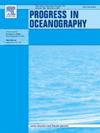Little seasonal variation of mercury concentrations and biomagnification in an Arctic pelagic food web
IF 3.8
3区 地球科学
Q1 OCEANOGRAPHY
引用次数: 0
Abstract
Despite numerous studies on mercury in Arctic biota, data from inaccessible, ice-covered regions − especially during the polar night and late winter − remain scarce. This scarcity results in poor understanding of the seasonal dynamics of mercury within the food web. From the Northern Barents Sea, we quantified total mercury and the dietary descriptors δ15N and δ13C as long-term dietary signals (weeks to months) in biota to a) investigate the seasonal pelagic food web structure, b) seasonality in total mercury concentration, c) and its biomagnification in the food web. Mercury and dietary descriptors were analyzed in copepods, macrozooplankton (krill, amphipods, arrow worms, and pteropods) and the fishes, Atlantic cod (Gadus morhua), polar cod (Boreogadus saida) and capelin (Mallotus villosus) during spring, late summer, early, and late winter. Seasonal changes were observed in δ15N values in some macrozooplankton and capelin, and some seasonal variation was observed across the food web with depleted δ13C values in spring and enriched δ13C values in late summer. Mercury concentrations were lower (range: 2.49 ng/g dw in the krill Thyssanossa sp. – 70.55 ng/g dw in the pelagic pteropod Clione limacina) than reported from other parts of the Arctic. We found a positive linear relationship between mercury and relative trophic position represented by δ15N, i.e., biomagnification, during all seasons, except in early winter. As Clione limacina likely had different turnover rates for mercury and stable isotopes resulting in low δ15N, but high mercury concentrations in early winter, compared to the other species in the food web, the pteropod was omitted from the regression. By omitting Clione limacina, biomagnification was similar across all seasons (R2adj = 0.45). Thus, we saw clear mercury biomagnification with consistent and little seasonal variation in this high Arctic marine food web despite large seasonal fluctuations in abiotic and biotic conditions.

北极远洋食物网中汞浓度和生物放大的小季节变化
尽管对北极生物群中的汞进行了大量研究,但来自难以接近的冰雪覆盖地区的数据仍然很少,特别是在极夜和冬末。这种稀缺性导致人们对食物网中汞的季节性动态了解不足。在北巴伦支海,我们量化了总汞和膳食描述子δ15N和δ13C作为生物群的长期膳食信号(周至月),以研究a)远洋食物网结构的季节性,b)总汞浓度的季节性,c)及其在食物网中的生物放大。在春季、夏末、初冬和冬末对桡足类、大型浮游动物(磷虾、片脚类、箭虫和翼足类)和鱼类、大西洋鳕鱼(Gadus morhua)、极地鳕鱼(Boreogadus saida)和毛鳞鱼(Mallotus villosus)进行了汞和膳食描述物分析。部分大型浮游动物和毛鳞的δ15N值存在季节变化,整个食物网的δ13C值在春季呈下降趋势,在夏末呈上升趋势。与北极其他地区报告的汞浓度相比,汞浓度较低(范围:磷虾(Thyssanossa sp)为2.49纳克/克/天,远洋翼足类(Clione limacina)为70.55纳克/克/天)。除初冬外,汞与δ15N代表的相对营养位置(即生物放大)呈线性正相关。与食物网中的其他物种相比,翼足类可能具有不同的汞和稳定同位素周转率,导致δ15N低,但在初冬时汞浓度高,因此在回归中忽略了翼足类。忽略Clione limacina后,所有季节的生物放大率相似(R2adj = 0.45)。因此,尽管在非生物和生物条件下有很大的季节性波动,但我们在北极高海拔的海洋食物网中看到了明显的汞生物放大效应,并且具有一致的、很少的季节性变化。
本文章由计算机程序翻译,如有差异,请以英文原文为准。
求助全文
约1分钟内获得全文
求助全文
来源期刊

Progress in Oceanography
地学-海洋学
CiteScore
7.20
自引率
4.90%
发文量
138
审稿时长
3 months
期刊介绍:
Progress in Oceanography publishes the longer, more comprehensive papers that most oceanographers feel are necessary, on occasion, to do justice to their work. Contributions are generally either a review of an aspect of oceanography or a treatise on an expanding oceanographic subject. The articles cover the entire spectrum of disciplines within the science of oceanography. Occasionally volumes are devoted to collections of papers and conference proceedings of exceptional interest. Essential reading for all oceanographers.
 求助内容:
求助内容: 应助结果提醒方式:
应助结果提醒方式:


